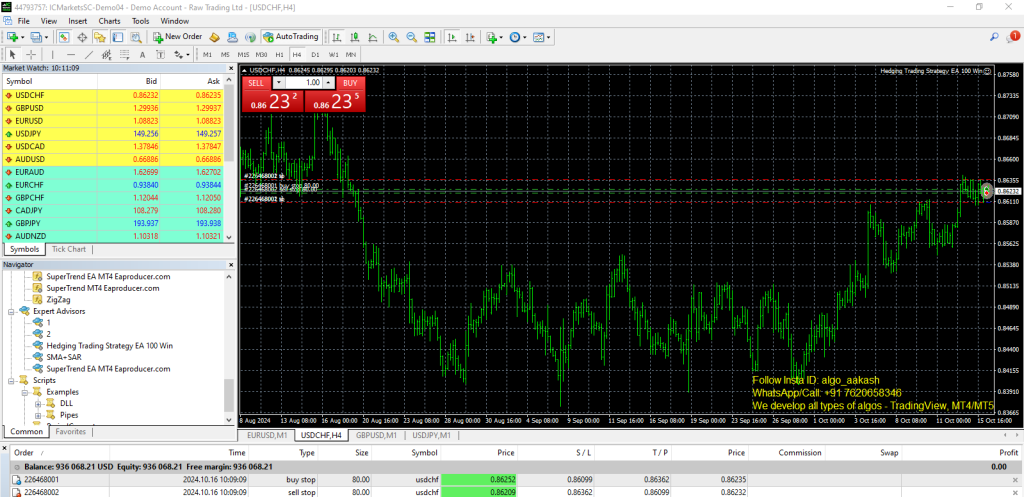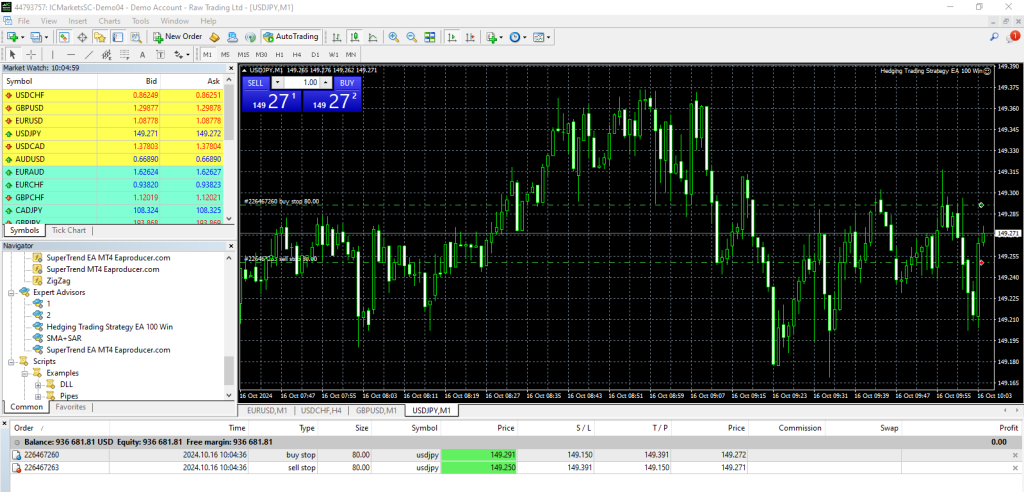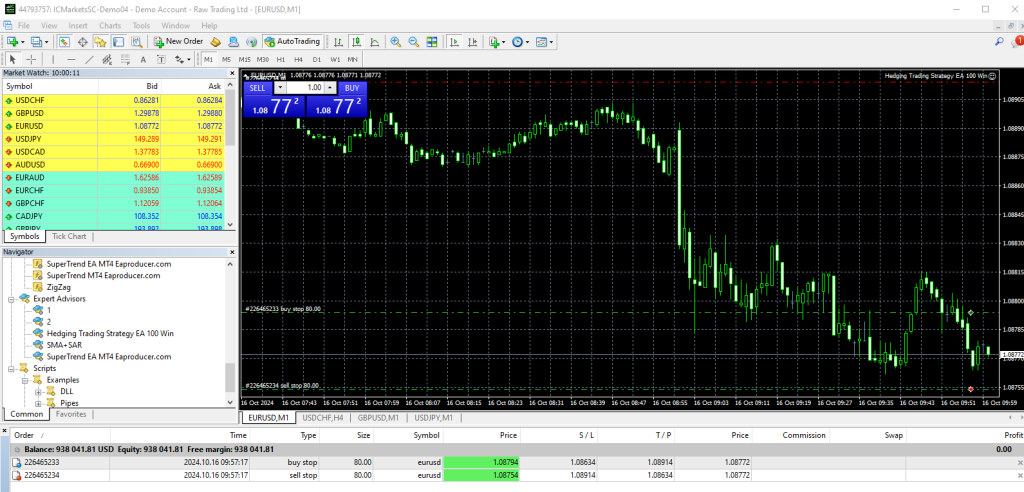🔓 Get All Tools for FREE!
- ✅ Click here to open a trading account using our referral link and start trading.
- 📅 After 7 days of active trading under our referral link, you can get access to all tools in your account.
- ⚠️ Keep trading to keep access free — if you're inactive for 7 days, your access will be removed.
- 👉 Already have an account? You can change the IB (introducing broker) to our referral link ( https://one.exnesstrack.org/a/w7syl3vnjb ) and still qualify!
In today’s fast-paced trading environment, the ability to adapt quickly and minimize risk is crucial. This is where an Expert Advisor (EA) comes into play. An EA is an automated trading system designed to execute trades on behalf of the trader based on predefined strategies. In this article, we’ll explore how a hedging EA works, its advantages, and why you should consider implementing one in your trading arsenal.
What is an Expert Advisor (EA)?
An Expert Advisor is a software program that runs on the MetaTrader platform, which is widely used for forex trading. EAs can analyze market conditions, execute trades, and manage positions based on specific algorithms and strategies. They can be particularly beneficial for traders looking to automate their trading processes or those who may not have the time to monitor the markets continuously.
This particular EA utilizes a hedging strategy, a method where two opposing trades are placed to manage risk. In essence, it places two stop orders—a buy order and a sell order—at a specified distance, usually around a 10-pip gap. By employing this approach, the EA can capitalize on market fluctuations, minimizing potential losses while maximizing the chances of achieving profits.
🔓 Get All Tools for FREE!
- ✅ Click here to open a trading account using our referral link and start trading.
- 📅 After 7 days of active trading under our referral link, you can get access to all tools in your account.
- ⚠️ Keep trading to keep access free — if you're inactive for 7 days, your access will be removed.
- 👉 Already have an account? You can change the IB (introducing broker) to our referral link ( https://one.exnesstrack.org/a/w7syl3vnjb ) and still qualify!

How Does the Hedging EA Work?
The functionality of this EA is both sophisticated and efficient, making it a valuable tool for traders. Here’s a breakdown of how it operates:
- Initial Setup: Upon initialization, the EA places two stop orders—one for buying and one for selling—set apart by a 10-pip gap. This initial setup is crucial as it lays the groundwork for the hedging strategy.
- Buy Triggered: If the market moves favorably and the buy order is activated, the EA seeks to secure immediate profit. This aspect is essential for capitalizing on short-term price movements.
- Sell Triggered: Conversely, if the market moves against the buy order and activates the sell order first, the EA doubles the volume of the positions. This doubling effect allows the EA to hedge against the potential loss incurred from the buy order.
- Profit Realization: If the sell order is profitable, both the buy and sell positions will close, locking in gains for the trader. This aspect highlights the EA’s efficiency in managing risk and ensuring profitability.
- Re-Entry: If the sell order fails to reach its target profit, the EA places another buy order with double the volume of the last sell order. This step ensures that the trader remains in the market, taking advantage of potential price reversals.
- Cycle Repeat: The process repeats until the target profit is achieved. This cyclical nature of the EA allows it to adapt continuously to market changes, making it a powerful tool in a trader’s arsenal.
Advantages of Using a Hedging EA
Implementing a hedging EA offers several benefits:
- Automated Trading: The EA eliminates the need for constant market monitoring, allowing traders to engage in automated trading. This feature is particularly advantageous for those with busy schedules or those who may not have the expertise to analyze market conditions continuously.
- Risk Management: The hedging strategy allows traders to manage risk effectively. By placing opposing trades, the EA can mitigate potential losses and secure profits, making it a valuable asset for risk-averse traders.
- Increased Profit Potential: The EA’s ability to double positions when the market moves against a trade can lead to increased profit potential. This feature enables traders to take advantage of price reversals and capitalize on market fluctuations.
- Backtesting Capability: Most EAs come with backtesting features, allowing traders to evaluate their strategies based on historical data. This capability enables traders to optimize their trading strategies and gain insights into their performance over time.
How to Get Started with a Hedging EA
If you’re interested in implementing a hedging EA, here are some steps to consider:
- Choose a Reliable Broker: Select a broker that supports MetaTrader and offers the necessary features for running EAs.
- Download or Develop an EA: You can either purchase a pre-built hedging EA or develop one tailored to your specific trading strategy.
- Test on a Demo Account: Before deploying the EA on a live account, always test it on a demo account. This step allows you to evaluate its performance without risking real capital.
- Monitor Performance: Once the EA is live, keep an eye on its performance. While EAs are automated, occasional monitoring ensures that it operates as intended.
Step-by-Step Guide to Set Up an EA in MT4
1. Download or Create the EA
- If you already have an EA, it will typically be in a .mq4 or .ex4 file format.
- You can download EAs from trusted sources or create one using the MetaEditor if you are comfortable with MQL4 programming.
2. Open MT4
- Launch your MetaTrader 4 (MT4) platform.
3. Locate the Experts Folder
- In MT4, go to the top menu and click on File, then select Open Data Folder.
- Navigate to the following directory: MQL4 > Experts.
4. Copy the EA to the Experts Folder
- Copy the .mq4 or .ex4 file of your EA into the Experts folder.
- If your EA has additional files like indicators or libraries, ensure they are placed in the respective folders (e.g., Indicators folder or Libraries folder inside MQL4).
5. Compile the EA (if using .mq4 file)
- If your EA is in .mq4 format, you need to compile it:
- Go to Tools > MetaQuotes Language Editor (or press F4).
- The MetaEditor will open. On the left sidebar, you will see the Experts section.
- Double-click your EA to open it in MetaEditor.
- Click on the Compile button (located on the toolbar, or press F7).
- Make sure there are no compilation errors.
- If you have the .ex4 file, this step is not required, as it’s already compiled.
6. Restart MT4
- After copying the EA into the Experts folder and compiling it (if needed), close and reopen MetaTrader 4 to ensure that the EA loads properly.
7. Attach the EA to a Chart
- Open the chart for the currency pair or asset you want to trade with the EA.
- In the Navigator window (on the left side of the platform), find the Expert Advisors section.
- Drag and drop the EA onto the chart.
8. Configure the EA Settings
- After dropping the EA onto the chart, a settings window will appear.
- Here, you can adjust various parameters, such as:
- Input settings: Variables for trading, risk settings, lot sizes, etc.
- Common settings: Enable or disable certain features like live trading, alerts, etc.
- Make sure to Allow live trading by checking the box in the “Common” tab.
- You can also enable Allow DLL imports if your EA requires external libraries to function.
9. Enable AutoTrading
- Ensure that the AutoTrading button (on the toolbar) is enabled. This allows your EA to execute trades automatically.
- The button should show a green play icon. If it’s red, click it to enable it.
10. Check EA Status
- After attaching the EA to the chart, you will see a small icon in the top-right corner of the chart:
- A smiley face means the EA is running and ready to trade.
- A sad face or cross means the EA is not running, and you may need to check if AutoTrading is enabled or if the settings are correct.
11. Monitor EA Activity
- The EA will now start working based on its algorithm.
- You can monitor its activity in the Experts and Journal tabs at the bottom of the MT4 terminal window to see logs, trade executions, or any errors.
12. Disable the EA (When Needed)
- To stop the EA from trading, either remove it from the chart by right-clicking on the chart and selecting Expert Advisors > Remove, or you can disable the AutoTrading button.

https://drive.google.com/file/d/13msW2swScH9sZC4UZprJ65Wa8UxkG38E/view?usp=drive_link
Conclusion
In summary, a hedging Expert Advisor (EA) represents a powerful tool for traders aiming to enhance their trading strategies through automation and effective risk management. By leveraging a dynamic approach that places opposing stop orders, this EA allows traders to capitalize on market fluctuations while minimizing potential losses. With features such as automated trading, increased profit potential, and the ability to adapt to changing market conditions, a hedging EA can significantly improve your trading experience.
Disclaimer
Trading involves substantial risk and is not suitable for every investor. Past performance is not indicative of future results. It’s important to understand the risks involved and seek independent advice if necessary. Always test trading strategies on a demo account before trading with real money, and remember to use risk management techniques to protect your capital.
🔓 Get This Tool for FREE!
- ✅ Click here to open a trading account using our referral link and start trading.
- 💡 Use coupon code: FREE during checkout.
- 📅 After 7 days of active trading under our referral link, you’ll get access to this tool in your account.
- ⚠️ Keep trading to keep access free — if you're inactive for 7 days, your access will be removed.
- 👉 Already have an account? You can change the IB (introducing broker) to our referral link and still qualify!

0 Comments